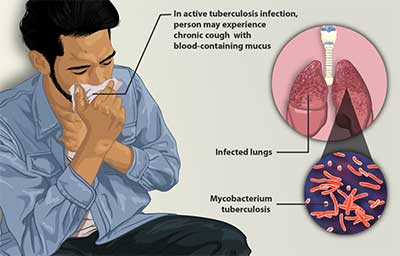Relevance: GS-2: Issues Relating to Development and Management of Social Sector/Services relating to Health, Education, Human Resources.
Key Phrases: Tuberculosis, NIKSHAY
Why in news?
- India is poised to miss its annual target of 2.4 million Tuberculosis (TB) case notifications defined in the draft National Strategic Plan (NSP)
Analysis:
What is Tuberculosis (TB)?
- TB is caused by a bacterium called Mycobacterium tuberculosis, belonging to the Mycobacteriaceae family
- In humans, TB most commonly affects the lungs (pulmonary TB), but it can also affect other organs (extra-pulmonary TB).
- TB is a treatable and curable disease.
- TB is spread from person to person through the air. When people with lung TB cough, sneeze or spit, they propel the TB germs into the air.
Status of TB
- India contributes to 27% of the global TB burden, the highest share globally.
- In 2020, there were 18.05 lakh TB notifications, which was a fall of 24 per cent from 2019 due to the disruptions caused by the Covid-19 pandemic
- Due to lockdowns, notifications fell by 38 per cent and 44 per cent in the public and private sectors respectively.
- About half of all people with TB can be found in 8 countries: Bangladesh, China, India, Indonesia, Nigeria, Pakistan, Philippines and South Africa.
Causes of such case load
- Poverty: The social conditions of millions of people in India is still far away from normal. Poverty is still a big problem in India associated with problems of undernourishment and poor and unhygienic living
- Underreporting: One of the major factor of TB prevalence in India is under-reporting of TB cases. This leave risk of spread of TB to other healthy individuals.
- Treatment: Inequitable access to quality diagnosis and treatment remains a major issue in combating tuberculosis. Further, the private sector which contributes a major part of TB care is fragmented, made up of diverse types of healthcare providers, and largely unregulated
- Drug resistance to TB: Standard TB treatment is not followed uniformly across the private sector, resulting in the rise of drug resistance
- Issues with RNCTP: Weak implementation of Revised National TB control program at state level is another major concern.
- Social Stigma: Patients often hesitate to seek treatment or deny
their condition altogether for fear of social discrimination and
stigmatisation.
India’s efforts - National strategic plan for TB elimination:Roadmap for coordination between tuberculosis control and tobacco control programmes- provides smoke free health facilities
- Launched successful TB cough mass media campaign: Depicts association between TB and smoking-one campaign TB haarega desh jeetega (TB will lose, country will win) with 3 pillars-clinical approach, public health component, active community participation, private engagement
- World bank and GOI signed 400MD loan agreement for programme towards elimination of TB-to support national strategic plan
- Nikshay Poshan Yojana: In which TB patients receive Rs 500 every month while on treatment was launched.
- By applying “multi-sectoral and community-led” approach, the government is building a national movement to end TB by 2025.
How is Covid affecting India’s fight?
- WHO’s Global TB report 2021 placed the global gap at about 1.4 million cases for 2020 and attributed to redirected resources owing to the COVID-19 outbreak.
- India contributed the biggest drop in case notifications last year, indicating that a large number of cases went undetected. About 41 per cent of all cases dropped in 2020 came from India.
Way ahead
- Government should build accountability among health professionals and ensure sufficient and sustainable financing to provide access to prevention and treatment.
- All hospitals should create an after care system in which every TB case should be followed up regularly at periodic intervals.
- It is important to address the social conditions and factors which contribute to and increase vulnerability to tuberculosis.
- We must provide both treatment and legal literacy to people with TB, so that they understand their rights and can speak up if these are violated.
Source: Down Earth









